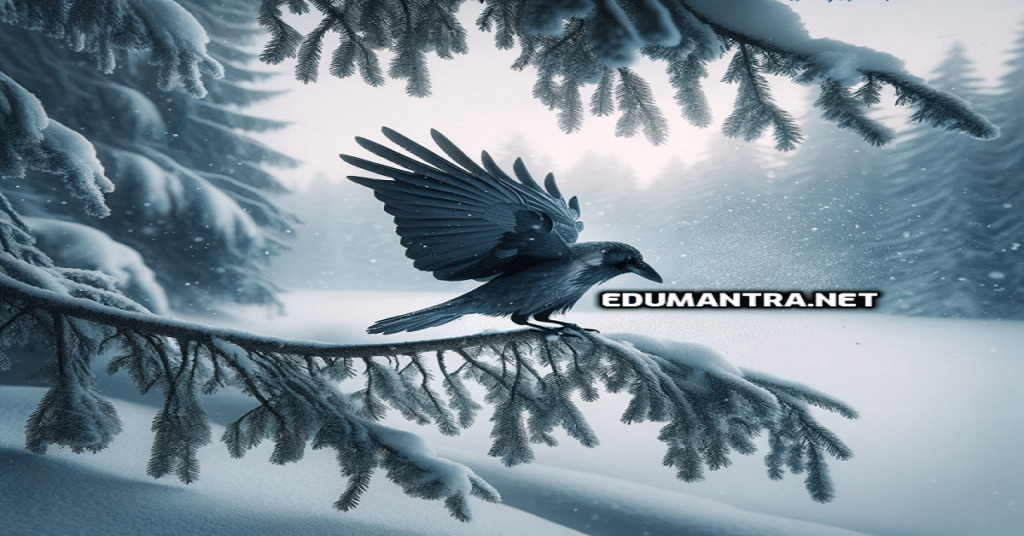
Here is Dust of Snow, a detailed exploration and explanation of the figure of speech and its many facets. In this post, we have explained various examples of figurative speech, providing a comprehensive understanding of Dust of Snow in terms of all Poetic Device. We have also told the reason why a particular figure of speech occurs in a particular line. This is going to help the children of various classes Class X. Dive in for figure of speech examples-
Table of Contents
Figure of Speech in Dust of Snow Stanza 1
The way a crow
Shook down on me
The dust of snow
From a hemlock tree
1. Figure of Speech: Metaphor
Exact Line: “The dust of snow”
Reason: The snow is metaphorically referred to as “dust,” implying its lightness and the subtle impact it has, like dust particles. This metaphor enhances the delicacy and ephemeral nature of the snow, adding depth to its description.
2. Figure of Speech: Personification
Exact Line: “Shook down on me”
Reason: The action of the crow shaking down the snow is personified. This personification attributes human-like actions to the crow, giving life and animation to the scene, making it more vivid and relatable.
3. Figure of Speech: Imagery
Exact Line: The entire stanza
Reason: Imagery is used throughout this stanza to create a vivid picture in the mind of the reader. The description of the crow, the snow, and the hemlock tree conjures a clear and specific image, engaging the reader’s senses and imagination.
4. Rhyme Scheme: abab
Explanation: The rhyme scheme of this stanza is abab, where “me” and “tree” form the ‘a’ rhyme and “crow” and “snow” form the ‘b’ rhyme. This pattern contributes to the musical quality and rhythm of the poem.
5. Symbolism:
Symbols: “Crow” and “Hemlock tree”
Reason: The crow and the hemlock tree are used symbolically to represent emotions like dejection, gloom, and depression. Frost uses these traditionally inauspicious symbols of nature to convey a deeper message that even elements considered gloomy or unfavorable can bring about a positive change in a person’s mood and mindset.
Also Read:
- Dust of Snow Long Question Answer English
- Dust of Snow Extra Question Answer English
- Hard Words : Dust of Snow
- Dust of Snow NCERT Solutions
- Dust of Snow Extract Based MCQ Questions
- Dust of Snow- Short Summary
- Dust of Snow- Short & Detailed Summary

Dust of Snow Poetic Device- Stanza- 2
Has given my heart
A change of mood
And saved some part
Of a day I had rued
1.Inversion
Exact Line: “Of a day I had rued”
Reason: The normal sentence structure is altered here for the sake of rhyme and rhythm. In everyday language, it would typically be expressed as “A day I had rued.”
2. Enjambment
Exact Line: The entire stanza
Reason: The sentence flows over the line breaks without punctuation, creating a seamless and continuous thought process, evident throughout the stanza.
3. Metaphor
Exact Line: “A change of mood”
Reason: This line continues the metaphor from the first stanza’s “The dust of snow,” symbolizing the transformative effect of nature on the poet’s mood.
4. Synecdoche
Exact Line: “Has given my heart”
Reason: Here, “heart” is used to represent the poet’s entire emotional state, highlighting the profound effect of the natural event on his overall mood.
5. Assonance and Alliteration
Exact Lines: “Has given my heart“
Reason: The line exhibits both assonance and alliteration. The assonance is marked by the repetition of the ‘a’ sound in “Has” and “heart,” contributing to the melodious quality of the line. Additionally, there is alliteration with the ‘h’ sound in “Has,” “given,” and “heart.” This alliteration creates a soft, harmonious effect and emphasizes the gentle, introspective nature of the stanza. The combined effect of assonance and alliteration in this line enhances the lyrical and reflective tone, resonating with the theme of internal transformation.
Also Read:
- Dust of Snow- Important Extra Questions- Short Answer Type
- Dust of Snow- Important Extra Questions- Very Short Answer Type
- Dust of Snow- Extract Based comprehension test Questions
- Dust of Snow- Comprehension Passages
- Dust of Snow- Summary in Hindi – Full Text
6. Alliteration
Exact Lines: “Has given my heart” and “And saved some part”
Reason: The use of ‘h’ and ‘s’ sounds in these lines creates a rhythmic flow and draws attention to the theme of transformation.
7. Rhyme Scheme: abab
Exact Lines: “heart” (b), “mood” (a), “part” (b), “rued” (a)
Reason: This rhyme scheme continues the musical quality established in the first stanza and helps to unify the poem’s structure.